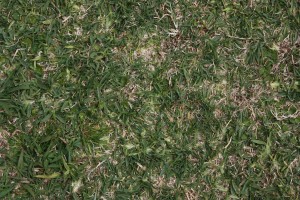 The leaves on your trees will yellow in fall, but your grass shouldn’t. Changes in grass color can be an indicator of lawn rust, a fungus that can hamper your grass’ growth and its ability to survive the winter. Fortunately, this problem is easy to deal with if caught soon enough.
The leaves on your trees will yellow in fall, but your grass shouldn’t. Changes in grass color can be an indicator of lawn rust, a fungus that can hamper your grass’ growth and its ability to survive the winter. Fortunately, this problem is easy to deal with if caught soon enough.
What is Lawn Rust?
This fungus starts as yellowing grass blades, then turns orange, red or brown when it starts making spores. On closer inspection, this colorful coating is a fine dust that can be wiped off of the blade.
Lawn rust starts growing on grass that has been wet for 6-8 hours. Cool nights with heavy rains and dew can create the perfect conditions for the mold to grow, while excess thatch can hold onto moisture to let the spores take root. In most of the northern U.S, fall conditions are perfect for the growth of rust.
Why is Rust a Problem?
The coating created by the mold keeps sunlight from reaching the chloroplasts inside the grass, stopping photosynthesis. Without this process, the grass can’t make the carbohydrates it needs for fuel, causing it to thin out. Prolonged periods of rust coverage in the fall can keep the grass from storing enough food to last the winter. This makes it more susceptible to snow molds, which can kill the grass entirely.
What Can I Do to Prevent Rust?
Prevention starts with controlling moisture. Water early in the morning to give the soil time to absorb the moisture before peak mid-day temperatures. If you have a sprinkler system, make sure it’s off after heavy rains so it won’t add to the problem.
Thatch is the layer of woody, dead material that forms on top of the soil. A small amount promotes microbe growth, but a layer of over a half inch thick should be removed to keep water off of the blades of grass. It may sound counterintuitive to mulch when you have thatch issues, but the easily digested bits of grass left behind promote microbe growth. These added microbes break down thatch faster to keep it from building up.
Unlike most fungi, lawn rust thrives in soils low in nitrogen. Fertilizing your lawn this fall to keep the soil’s nutrients balanced can limit mold growth.
If rust is a frequent occurrence, consider seeding fungi-resistant grasses like Kentucky bluegrass and ryegrass.
How do I Get Rid of Rust?
The same steps used to prevent rust can also halt an infestation. Without moisture and the right soil conditions, the fungus will quickly die off. After mowing, wash your shoes and mower to keep spores picked up from infected areas from being spread across your lawn.
In most cases, rust can be managed without needing to resort to fungicide, but there may be spots on your lawn where poor drainage, shade, and other conditions make the area prone to infection. Most general fungicides are effective against lawn rust if applied correctly: the lawn needs to remain relatively undisturbed until the product dries, and temperatures need to remain cool, typically below 85 degrees. Try to apply the fungicide at least two days before and two days after mowing for maximum effectiveness.
Be Ready to Defend Your Lawn from Infestations
From mowers to dethatcher attachments, if it’s Cub Cadet, you can get everything you need for it at www.cubparts.com. As a certified Cub Cadet dealer, we’re able to offer replacement parts and accessories for everything from the company, past, and present. Our site makes it simple to find what you need with built in parts diagrams, and we can ship your order to any address in the U.S. or Canada.
